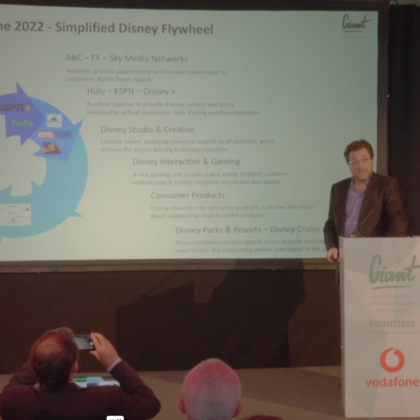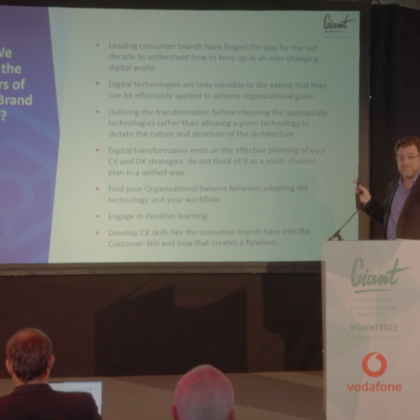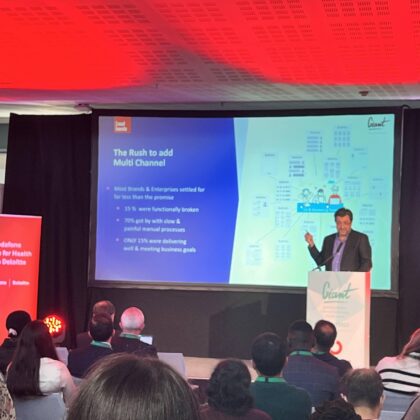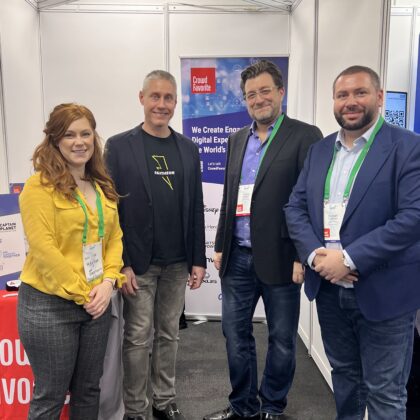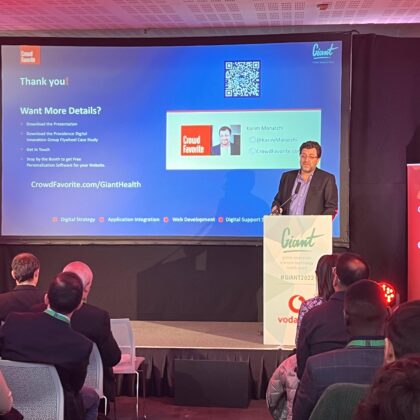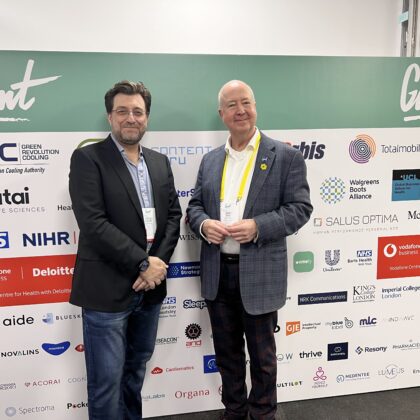The Digital Future of Healthcare: Advancing the Patient Relationship through Digital Experience Technology
The Healthcare Industry is looking to deliver 21st century care with a focus on customer experience and customer interaction strategies.
After decades of slow or no churns in the patient administration management, the expectation is now to move at digital speed. While digitally enabled care is going mainstream across the UK, fast-paced changes in technology can be extremely disruptive to the clinician workflow. Internally, many hospitals and practices are having a hard time with keeping up with this change. Clinicians are being told to deliver 21st century care with a focus on customer experience and customer interaction strategies.
There's a promise to what's happening in the healthcare industry. That promise is focusing around five areas of in-depth technology. Let's take a closer look at how technology is impacting the digital future of healthcare.
What Did We Learn in the Last 10 Years of Consumer Brand Investment?
- Leading consumer brands have forged the way for the last decade to understand how to keep up in an ever-changing digital world.
- Digital technologies are only valuable to the extent that they can be effectively applied to achieve organizational goals.
- Defining the transformation before choosing the appropriate technologies rather than allowing a given technology to dictate the nature and structure of the architecture.
- Digital transformation rests on the effective planning of your CX and DX strategies, do not think of it as a multi-channel plan in a unified way.
- Find your organizational balance between adapting the technology and your workflow.
- Engage in iterative learning and adapt your approach as you go.
- Develop CX skills like the consumer brands have into a Customer 360 focus.
Businesses just looked for new technology without understanding how it would affect their staff. The key here is to focus on strategic objectives, not on technology.
– Karim Marucchi

Takeaways from Giant Health Future Hospital Show
- Healthcare needs to find a balance between adapting to the technology and limiting the workflow changes to staff.
- The key is personalization. Personalization for the patient, but also personalization for the clinician and the clinician staff.
- Analytics are more powerful than ever. Use them. Not only in marketing, but in customer service and your experience.
- Caring for patients no longer means that they must have a visit for everything.
- Self-service scheduling, bill pay, and financial inquiries can reduce call volumes and administrative time.
- These benefits also address the growing issues around workforce burnout and constant retraining. If you have good staff, you want to keep them.
- Focus on the human experience, make your technology work for that.
Thank you to Providence Digital Innovation Group for partnering with us for this talk. DIG THIS: Why HealthCare Needs a Flywheel
Slides From The Talk
Video Transcription
| Karim | Thank you, thank you very much. Hello, and good afternoon. Thank you very much for spending the time to come and see this. I'd like to thank Giant Health and Barry for his invitation to come and share some time with you all. Crowd favorite is a digital consultancy with over 20 years of leading customer experience integrations for large brands. We don't make or sell any of the products or platforms out there. We represent our clients in trying to pick the best solutions and trying to adapt them for their needs. After we help choose digital experience solutions for our clients, we use Open Source technologies to create a process of an integration layer that keeps our clients in the driver's seat of how they're using their technology. As you can see, while healthcare clients are in our roster, we work with a lot of Brand industry leaders. You might ask yourselves how our clients choose us rather than go with vertical industry experts. Well, technology and innovation rarely stick to one vertical, and we're hired because we can bring our expertise across different industries very easily. The last part of this presentation will bring us into how you actually bring it into healthcare, and I hope it's very, very relevant here. What I'd like to do is start by just touching on things that you know, but you'll see how they're relevant. Here in the UK, like it or not, the patient relationship and their expectations are on the move. Everyone speaks to the pandemic changing things, but what we've clearly seen, it's not only accelerated what was already clearly a trend, it's just made things move faster. Industries that were laggard in how they adapted technology are now being pushed as never before. On the left, we are seeing the result of a sharp climb in patient frustrations. We're seeing call centers being swamped as patients are getting frustrated with the data that you see on the right of the screen that's saying clearly they're not finding what they need through different channels of interacting with their providers and clinicians. After decades of slow or no churns in the patient administration management, the expectation is now to move at digital speed. While digitally enabled care is going mainstream across the UK, fast-paced changes in technology can be extremely disruptive to your clinician workflow internally, a lot of hospitals and practices are having a hard, hard time with keeping up with this change. Clinicians are being told to deliver 21st century care with a focus on customer experience and customer interaction strategies. There's a clear trend in helping push patient DIY on many levels of care. Will this help or hurt clinicians and patients? Some people love using their phones to put in patient data. Other people are just saying, "I don't want to do this. I expect to be able to just fill out the form and deal with it." How is that helping? Well, there's a promise to what's happening in this industry, and that promise is around five areas of in-depth technology that we're seeing an ever-growing balance on. Right here at this conference, you can see how fast technology is ramping up. Notice how most are pushing towards clinician administration and customer experience. They're not pushing towards just getting the results to the patients and actually the healthcare. Trends in telemedicine, VR, and AR are exciting and do help in the patient. AI is helping doctors interpret timely diagnosis for their patients, and that is amazing. But as we will see in the brand's part of this presentation, it's AI that is creating intelligent call routing and reducing messaging volumes to providers. Clinicians can see the benefit of improved patients' experience and aid the growing of the practice. This is a lot to deal with, but we are told the technology will just solve it. Just use this technology, and magically, your customer experiences are going to be better for your patients. Does that look simple to you? Does everybody want to learn every single one of these technologies deeply? Really, it's really not that simple. I'm going to assume that this incredible shift of the last few years has not been easy for this room. If anybody disagrees, please raise your hand, has it been easy? Thought so. How many of you have been thrown at technology with a promise that this technology is going to fix our customer experience? So is there a roadmap that we in healthcare can take a look at? Is there somebody who's done this for the last 20 years outside of healthcare that there may be some lessons to learn? Well, if we're going to look for a usual analogy, let's quickly define the problem of customer experience and digital experience to see if it's going to help. So for those of you who haven't dealt with this in recent years, really now they're looking at the customer as a 360 degree experience, no longer just based on one or different channels. See the pretty graphic that shows you six easy ways to interact with your clients? The promise here was it's going to be that simple. Leading brands have moved from defining a small amount of direct channels to what they call the omni-channel presence. If omni-channel meant six, they wouldn't call it Omni. They'd say, "It's basically just six channels. No problem. We can handle it. This experience is designed to make it easier to empower customers to find what they need." Omni-channel was seen as a way to provide customers with a seamless integrated experience whenever they interact with the company. This is what they got. That pretty graphic and the promise of ease turned into multi-channel and omni-channel. So for multi-channel, not omni-channel, what really developed was a nightmare that grew every year. Year over year from 2011 where you see 150 customer experience platforms to almost 10,000 customer experience platforms today. Anybody want to sort through 10,000 customer experience platforms, try and figure that out, and figure out which is the best for the practice? Well, consumer brands competed. They said, "Okay, we're going to pick one of these and try our best and churn from one solution to the other." This created more and more customer experience and digital experience products than ever. So how did that work for these brands? Not well, not well. In our experience, the CX and marketing teams not only grew in unimaginable ways, but were constantly churning workflows and constantly retraining. At first, the volume of added processes and the change in established processes were not working. They just looked for a new technology without studying the underlying process, without understanding how it would affect their staff, their cast, their way of doing things. The key here is to focus on strategic objectives, not on technology. Defining the transformation before choosing the technology became paramount. Technology to dictate the nature of the structure didn't work. You had to figure out what the workflow was for your specific staff. Locally, from city to city, from region to region, it changes. It's not an American versus UK British thing. It's literally based on local workforce expenditure, workforce experience. You have to understand what your challenges are going to be. So where can we look for a relevant example? Well, for this talk, I decided to look at the happiest place on earth. Disney has long been a leader in providing exceptional customer experiences, but in 2010, they had spent the last 10 years churning and learning from one digital strategy to another. They viewed their experiences with their customers and consumers physically, completely separately than the ones online. The ones online were just a sales channel to get them to come to their parks, to their experiences, to see their movies. It was seen as a separate interaction. As you can imagine, this led to years of giant spending and churn and solutions without a master customer experience plan across real and digital worlds. It wasn't seen singly; it was seen as something to be kept separately. So what was a C change and how did they look at what a unified CX experience could be? Well, it was a DX strategy. And to put it simply, they looked at the flywheel, the flywheel effect of how do I get my customers not to just go through a journey, but create small iterative cycles of becoming a better customer. And in their case, sell more and more things to them. Well, as I'm sure you know, this is not a one-way journey; it's sort of a loop, and small wins can accumulate over time. What did this strategy get them? This massive empire that still has one of the best NPS (Net Promoter Score) of any institution out there. Today, whether in person or digitally, the entire customer experience and digital experience strategy are not looking at sales or just providing experience as an endpoint, but continuous relationships that focus on customers and what they call cast or crew members. This fuels growth in customer base and spend per customer. So not only are they growing the literal base of customers, but they're actually growing what the customers are spending. They've been able to move horizontally, as you can see with all their purchases, within their market space to say, "We're going to move out of one sector and help with the sister sectors to what we're doing." Well, that's what you can see from the outside, but truly, they haven't quadrupled and quintupled in size in the last 10 years. How do they achieve this? Well, to look at how they're dealing with their digital experience and their customer experiences, we have to find the balance of human and digital workflows. So this is an example of studying a workflow before picking a technology. Way over there, you'll see that in one project, they take these workflows and they actually map them out, and they ask, "In location X or Y, how does that work and how does that adapt to the local staff? How do we work with that?" Then they might come in and say, "Okay, let's adapt the software." Anybody here used in the past for private publishing, WordPress, anybody? Okay, you know that if you install a bunch of things in WordPress, you get a very complex menu, and it's very hard to use. This purple menu up here is a WordPress menu for a marketing site at Disney. It doesn't start with a product or service. It doesn't start with a plug-in. It doesn't start with technology. It starts with what is your task, and what is your function. And that enables us to change the outcome for the backend for the staff. In this last image over here, you're seeing what they're seeing in the backend, and that doesn't just come from their website, that comes from ticket sales, that comes from food sales at the park, that comes from campaigns online and offline. So they're understanding the real cost to the product and the staff workflows. What they're doing is they're creating customized workflows that are not just based in technology, they're based on that skillset. Rather than being a one-size-fits-all mega technology, rather than saying, "Okay, there's a platform out there that competes that says it can do everything," they're picking best-of-breeds, and they're saying, "Let's integrate those." So with these proven and improved workflows, what were they able to do? They were able to create, this is just a marketing example for ease of use, but they're able to create this unified linear experience where content editors and staff who don't need to be schooled in marketing strategy could be taken through that very complex workflow that you saw a couple of slides ago into four easy screens. And those four easy screens would automatically spit out a campaign that's already been set out for them. So this allows us to spend more time on the strategy, on implementing the product or service. It dramatically lowers the time on retraining, because if you want to change from WordPress to some other CMS underneath, you have this level above that's keeping you above it, and you're dealing with that, so they can swap out pieces of that infrastructure that aren't working for them. In a successful integration of customer experience, technology organizations stop seeing and feeling the functions. They start looking for the business results. So if you're seen as rewarding the experience not only for your patients or your customers, but also for your own staff, that focus needs to keep the technology adapting. So this wouldn't be a technical talk without at least one technical slide. So this is it, I'll get it out of the way, and we'll get back to our topic. But that unified process over here that we see under the hood, it looks something like this. This is what we call a digital experience platform that isn't just marketing; it's also adapting all the customer information, it's adapting all these wonderful pieces of SaaS software that are out there, but it's unifying them with one cohesive plan. If anybody really wants to get more into this, please come and see us afterwards. We'd be happy to explain how some of this stuff works. But you can work with any of the providers at this show, any of the best of practice providers that you find. It's a matter of the strategy and getting the right people to help you implement it. So I'm going to step back if anybody wants to take a photo. These are the takeaways of the last 20 years of major consumer brands, of what they've learned with experience platforms, digital experience platforms, and the customer experience. This is the, "I want to show you what I learned at the conference slide," and then I'll jump into it. I won't read through these, but the bottom line here is these companies have spent billions of dollars over the last two decades. When they've achieved their organizational goals, what they were doing is, before choosing the technology, they dictated the structure of what the result was. Don't think of it as a multi-channel plan, but a unified strategy. Find a balance between adapting to the technology and limiting the workflow changes to your staff. If technology is supposed to help you, it's supposed to adapt to your workflow. That doesn't mean you can't iterate and make a better workflow. We always find better ways to do things as we're practitioners of our specific expertise, but it doesn't mean you have to be held captive by technology. So let's see how that can be applied to healthcare. As discussed, some of these top leading brands are creating a sustaining patient relationship or customer relationship. The key here is personalization, personalization for the patient, but also personalization for the clinician and the clinician staff. What we're seeing is that, as new consumers are coming online, as we're moving through the current generations, not on a yearly, but on a quarterly and monthly basis, expectations are growing of that flywheel of relationship between clinicians, providers, and patients. So how do you do that? How do you personalize that? Our good friends at Providence Healthcare, their digital innovations group, just did a study that really shows and does a lot of research around this pie chart here. And what they've discovered is that patients educate themselves through complete digital experience, not just online information or thinking about their EMRs. Their medical records are just a piece of the journey. In the news, all we hear about is privacy, privacy, EMR, this, that EMR, the other. But the honest truth is that they're looking to have the same relationship with you that they're having with Disney, believe it or not. Ask them the questions. Remember one thing, you are not your own clients. You are not your own patients. Though being experts in your own field, you have to get outside of your head and think about their experience. Your expectations as medical practitioners and clinicians are very different from the on-the-street consumer. This pie chart of needs is growing and will continue to grow. Analytics are more powerful than ever. Use them. If you're not using analytics, not only in your marketing, but in your customer service and your experience, get on that. It's the most important thing you can do. People are scared of things like net promoter score, NPS ratings. It's the best thing you can do, because if you've got a low number, you can find out how to fix it. If you've got a high number, you've got a marketing point. By merging analytics and iterating, patients can automatically be directed to available solutions that best match their needs. That also provides you with an opportunity to understand how their needs are growing. Caring for patients no longer means that they must have a visit for all the things. It does mean that you can start having these other experiences with them. Finally, you can see how that flywheel took the pie chart from the last slide and created a complete interaction and increased efficiencies, reduced costs, especially for the mundane and repetitive tasks. Self-service scheduling, bill pay, and financial inquiries can reduce call volumes and administrative time. These benefits also address the growing issues that have been ignored up until now, those growing issues around workforce burnout and constant retraining. If you have good staff, you want to keep them. Focus on the human experience, make your technology work for that. So while you are literally focused on these iterative cycles of efficiencies, they are in fact part of an outward-facing customer experience. Even though you're focusing internally, you're actually helping the client experience, you're helping the digital experience by making sure that your staff is taken care of. I hope this brief look has helped. It does get much deeper. If somebody has a particular question, I'd be happy to take it now from the stageThis presentation will be put up for download as soon as I'm off stage. And then at that same URL, you'll be able to download the white paper from Providence as well as get in touch with us or ask more complex questions that I may not be able to answer from here on stage. Thank you. |
| Tom | Hi, I am Tom. Thanks for the presentation. Just curious, how are you doing it? You were talking about a layer on top here. So let's say I'm the hospital system or whatever, and I've got to deal with Epic EHR, and then all of the other stuff that's been procured by various IT departments. Are you just building a layer on top, which is a UI, and then are you using your integrations to plug into that? |
| Karim | So the short answer is no, and I could walk off stage. But thank you for the question, Tom. The bottom line here is if you were talking 10 and 15 years ago, everybody would be trying to sell you a software package. There is so much open source software out there that there are agencies like ours that specialize, consultancies like ours that specialize in taking an integration layer, whether it's around here or around here, to take off the shelf products and some best of breed SaaS and just make what are technically called APIs, and then focus on that last little bit, which is literally what they see on a browser or the interface. It's very fast. The complexity is in the planning, and then the execution of that layer is made as long as you're architecting it in a way that you can stay detached. You can switch from one customer service platform to another, really. So that's why these large brands are saying, "I respect Salesforce, I respect HubSpot for email marketing, but I don't want my staff to be dependent on only their functions." So they're spending the planning and the iteration time for just a quick layer on top of that using open source and simple tools to create that layer. They get that ROI directly back by not retraining their workforce once they have this in place. Does that answer the question? |
| Tom | Yes. So essentially you are using the open source tool, so you mentioned WordPress there to create that UI layer. And you're doing it very quickly, because you don't need to... It's essentially customized configuration mainly, and then you're doing the API calls for the integrations. Do you have any integrations with EHR, so let's say like Epic? |
| Karim | Yes. |
| Tom | Yeah. You say you've got all the fire and all the HL7 and all of that mess basically. |
| Karim | Yeah, exactly. We do that, and even past that. Are you familiar with Janice Henderson, the financial firm? Okay, so there's a financial firm that has all sorts of rules here in England and in the US, and they're using WordPress, the same blogging tool we all use privately as the front-end interface to manage the rules of what does show up for their clients after they log in. So you can integrate into these deeper tools, whether it's the tools you mentioned or these other financial tools, and still use something that sounds as simple as WordPress to actually create this management layer, and that's really the key that's made... Walt Disney Company has now redoubled their commitment to open source and the WordPress project for the next 10 years. |
| Announcer | Okay. Thank you so much. Any other questions? Karim, every conference I've been to the last 10 years, they just talk about interoperability. You seem to solve the problem for us, right? Is that right? |
| Karim | What we do is we take that problem away by literally making it an obsolete problem, because if you want to take out one thing and put in another, it's really up to the technology of the last five years have made it so that the API is a standard thing now, so that's also now allowed us to make sure that we can say, "Okay, while somebody might love," I'll use that example, "the HubSpot interface or the Salesforce interface, don't get locked into their roadmap." And that solves the problem. |
| Announcer | Yep. We have a problem with Cerner, Epic and others. We are locked into roadmaps, and that's part of the problem, I guess, right? Well thanks so much for traveling all the way from overseas to come and spend time with us. |
| Karim | You're welcome. Thank you for having me. |


